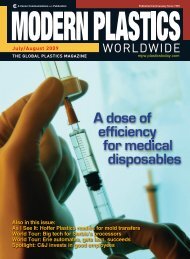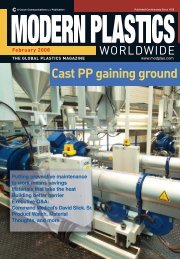amidiq - dae uptlax
amidiq - dae uptlax
amidiq - dae uptlax
Create successful ePaper yourself
Turn your PDF publications into a flip-book with our unique Google optimized e-Paper software.
2.3. Swelling kinetic<br />
N. Martínez-Vázquez et al. / Revista Mexicana de Ingeniería Química Vol. 6, No. 3 (2007) 337-345<br />
For the swelling characterization, three types<br />
of solution were used: acidic (pH of 4), basic (pH of<br />
10), and neutral (pH of 7, distilled water). The<br />
swelling tests were carried out at temperatures of 20,<br />
30, and 40 ºC, using a heating bath with controlled<br />
temperature. First, 1.3 cm 2 pieces were cut from each<br />
film (using a Vernier) and were weighed. This<br />
weight is considered the initial weight or WD. Each<br />
piece of a hydrogel was inserted into a vial inside the<br />
heating bath at each temperature, adding 0.01 g of<br />
solution (acidic, basic, neutral). The sample was<br />
weighed every 30 minutes for the first hour;<br />
afterward, every hour for the first 12 hours; and<br />
subsequently, every 24 hours until the sample<br />
stopped absorbing, the point at which there is<br />
desorption, or the swelling equilibrium is reached.<br />
The quantity of water retained inside the hydrogel in<br />
the equilibrium can be expressed mathematically in<br />
various forms (Katime et al., 2004), as is mentioned<br />
next—hydration percentage or weight swelling<br />
index:<br />
WS −WD<br />
WC<br />
( % ) = × 100 (1)<br />
W<br />
where: WC (%) is the hydration percentage, WS is the<br />
film’s weight after swelling, and WD is the weight of<br />
the dry film.<br />
The swelling degree was calculated using the<br />
following equation, where Dh is the swelling degree:<br />
wet weight<br />
D h = (2)<br />
dry weight<br />
The adequate temperature over the maximum<br />
swelling degree is established by the gravimetric<br />
method in agreement with the maximum water<br />
retention and the determination of the water absorbed<br />
by the hydrogel. This was carried out using Equation<br />
1; for all practical intents and purposes, swelling<br />
degree was used as a technical term for Wc.<br />
In order to determine the nature of the water’s<br />
diffusion toward the inside of the gel, the following<br />
equation was used:<br />
ln ( Wt / Wmax) = ln k + nln t (3)<br />
In this equation, Wt and Wmax represent the<br />
quantities of water absorbed by the gel in the time t,<br />
and in the equilibrium; k is a constant characteristic<br />
of the system, and n is the diffusional exponent that<br />
takes the water’s mode of transport into account. A<br />
value of n = 0.50 indicates a Fickian diffusion<br />
mechanism, while if it reaches 0.50 < n < 1, it<br />
indicates that the diffusion is of a non-Fickian or<br />
anomalous type. In the special case in which n = 1,<br />
the transport mechanism is known by the name of<br />
Type II and is particularly interesting due to the fact<br />
that the solute’s migration occurs at constant speeds<br />
and is purely controlled by the relaxation of the<br />
chains.<br />
This equation is applied to the initial swelling<br />
states (when the density of the device does not vary)<br />
D<br />
observing linearity when the ln (Wt /Wmax) is related<br />
in function of the ln t up to fractional swelling values<br />
less than 0.60 (Woerly et al., 1996).<br />
For the second kinetic order, the reciprocal of<br />
the swelling average (t / Wt) is related to the<br />
treatment time according to the following linear<br />
equation (Schott, 1992):<br />
t<br />
= A+ Bt<br />
(4)<br />
W t<br />
In this equation, A and B are two coefficients with<br />
physical meaning which are interpreted in the<br />
following manner: for long treatment times, Bt » A<br />
and the pending B will be the reciprocal of the<br />
swelling in the equilibrium (B = 1/Wmax). On the<br />
contrary, at very short treatment times A » Bt can<br />
reject Bt, and in this case A is equal to the inverse of<br />
the initial swelling speed<br />
⎛dW ⎞ 1<br />
lim ⎜ ⎟ =<br />
(5)<br />
t→0<br />
⎝ dt ⎠ A<br />
Therefore, the ordinate at the origin (A) represents<br />
the inverse of the initial swelling.<br />
2.4. Differential Scanning Calorimetry<br />
For equipment, A TA Instruments model 2010<br />
was used to research the behavior of hydrogels in a<br />
dry state after swelling. The sample quantity was<br />
approximately 10 mg. Two scans were carried out:<br />
the first scan at 10 °C/min, the second scan at<br />
5°C/min, in the range of 0 ºC up to 120 ºC with a<br />
nitrogen flow of 20 ml/min.<br />
2.5. Scanning Electromicroscopy<br />
The surface morphologies of the hydrogels<br />
were examined in a dry state after swelling using the<br />
EOL JSM 5900 scanning electron microcopies with<br />
an operating voltage of 5 Kv.<br />
3. Results and Discussion.<br />
In this case, swelling tests were carried out on<br />
the three ratios at different pH’s (acidic, basic, and<br />
neutral) and at temperatures of 20, 30, and 40 °C.<br />
In Fig. 1, the pH effect is observed; the<br />
MC/PAAm 3 (80/20, 1.0 wt% initiator and 1.0 wt%<br />
crosslinker) demonstrates acceptance toward the<br />
neutral pH, and strong interactions with water<br />
(hydrogen bond, OH groups of the solution with the<br />
material) occur. On the MC/PAAm 1 film (80/20, 0.5<br />
wt% of initiator and 1.0 wt% of crosslinker) the pH<br />
effect is not marked, but presents an inclination<br />
toward the neutral environment, and the water forms<br />
hydrogen bonds with the polymer’s polar groups;<br />
this is logical due to the fact that MC/PAAm 1 and<br />
MC/PAAm 3 have the same MC and PAAm ratio.<br />
MC/PAAm 2 (90/10, 1.0 wt% of initiator and 0.5<br />
wt% of crosslinker) behaves in a different manner<br />
toward the environments at different temperatures: at<br />
339









